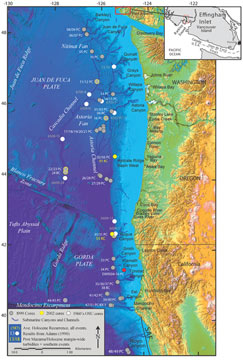|
NEWS NOTES
The ties that bind
 Courtesy of Chris Goldfinger |
| Dots mark the locations of the ocean sediment cores Chris Goldfinger and his colleagues used to find evidence of past earthquakes. |
Although the northern San Andreas Fault, which runs north from San Juan Bautista to Mendocino, Calif., has been relatively quiet since the 1906 quake that leveled San Francisco, it remains a menacing presence in California. Because no one understands exactly what will trigger the next earthquake, predicting when and where it will strike is, at best, an imprecise science. New data suggest, however, that what happens along the northern San Andreas Fault may be linked to what happens farther north, along the Cascadia Subduction Zone in the Pacific Northwest.
“This is not something we were ever looking for or suspected at all,” says Chris Goldfinger, a marine geologist at Oregon State University in Corvallis.
Goldfinger and his colleagues uncovered the potential relationship between the two active faults while using ocean sediment cores to sketch out the paleoseismic history of the region — a project that began more than a decade ago. In the course of their research, they noticed that many of the major earthquakes along the northern San Andreas appeared to occur at about the same time as earthquakes along Cascadia. “There seemed to be a timing coincidence,” Goldfinger says.
It was enough to convince the researchers to run a statistical analysis. They found that 13 of 15 earthquakes that occurred along the northern San Andreas Fault in the past 3,000 years were preceded by Cascadia earthquakes. On average, earthquakes struck the Cascadia fault zone between 25 and 45 years before earthquakes struck on the northern San Andreas Fault — a short amount of time, geologically speaking — Goldfinger and his colleagues wrote in the April Bulletin of the Seismological Society of America. That suggests that rupture along the Cascadia Subduction Zone might transfer stress southward, bringing the northern San Andreas Fault closer to failure.
Goldfinger is careful to note that there’s no way to prove that the correlation isn’t just coincidence. Mary Lou Zoback, a geophysicist for Risk Management Solutions in Newark, Calif., says that the sheer number of events suggests that it’s something more, however. “I think that it’s the strongest evidence that we’re ever going to get that these faults are linked,” she says.
But Harvey Kelsey, a geologist at Humboldt State University in Arcata, Calif., is more cautious. He points out that using the geologic record to date earthquakes is not a simple process. Goldfinger and his colleagues, for example, used turbidite deposits — debris from underwater landslides — as proxies for past earthquakes. To date these deposits, they looked at carbon-14 in tiny marine fossils trapped below the turbidite. That’s a valid method, Kelsey says, but it has inherent uncertainties, a point that Goldfinger acknowledges. “There needs to be a lot more work done on the timing,” Kelsey says. Zoback, however, points out that since the researchers used the same dating technique for both faults the errors would be consistent.
The idea that quakes along one fault can cause quakes along another fault, a concept known as “stress transfer,” is well accepted, Kelsey says. “It’s sort of like loading a gun,” Goldfinger says. But whether the idea applies to Northern California and the Pacific Northwest is not yet resolved. “We’re never going to definitively know from looking at the sediment record,” Kelsey says.
Part of uncertainty is due to the fact that the last major earthquakes in the region happened so long ago. The devastating 1906 earthquake was not linked to Cascadia and the 1989 Loma Prieta quake originated not on the San Andreas, but on a closely related fault. The most recent San Andreas earthquake that could be correlated to a Cascadia quake occurred about 1720, long before scientists began taking measurements. If Cascadia is triggering events along the northern San Andreas, the fault should rupture from north to south. But there’s no known record of whether that has ever happened.
Still, Goldfinger says that the field is progressing rapidly. He and his colleagues are already looking for ways to determine which way the northern San Andreas Fault has ruptured during past earthquakes. He expects that scientists will uncover enough evidence in the next decade or so to determine whether the two faults are linked. Of course, it could also happen much sooner, he says. “When Cascadia goes off next, then we’ll know.”

 Subscribe
Subscribe


